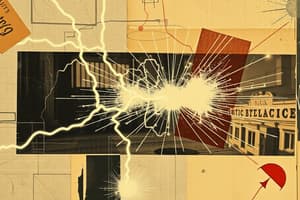Podcast
Questions and Answers
What happens when there is an imbalance of electrons within a material?
What happens when there is an imbalance of electrons within a material?
- Generation of static electricity (correct)
- Development of kinetic energy
- Formation of electromagnetic waves
- Creation of magnetic fields
What is one of the subtopics within physics that focuses on electric charges at rest?
What is one of the subtopics within physics that focuses on electric charges at rest?
- Kinematics
- Optics
- Electrostatics (correct)
- Dynamics
Which type of material tends to hold onto electrons, leading to the buildup of electric charge?
Which type of material tends to hold onto electrons, leading to the buildup of electric charge?
- Semiconductor
- Conductor
- Superconductor
- Insulator (correct)
What is the term used for the stationary charge that arises from a buildup of electrons on a nonconducting surface?
What is the term used for the stationary charge that arises from a buildup of electrons on a nonconducting surface?
In the context of static electricity, what happens when a person walks across a carpet?
In the context of static electricity, what happens when a person walks across a carpet?
What occurs when excess charge jumps from a person's hand to a conducting material like a metal doorknob?
What occurs when excess charge jumps from a person's hand to a conducting material like a metal doorknob?
What effect causes some strands of hair to stand on end due to repulsion of like charges?
What effect causes some strands of hair to stand on end due to repulsion of like charges?
Study Notes
Introduction
Physics is a broad field of science that studies matter and energy. One of the subtopics within physics is electrostatics, which focuses on electric charges at rest. Static electricity is a common manifestation of electrostatic phenomena, characterized by the accumulation of charges on nonconducting surfaces. In this article, we will discuss the formation of static electricity, examples of its effects, and its applications.
Formation of Static Electricity
Static electricity arises when there is an imbalance of electrons within a material. When different materials come into contact with each other, electrons can be transferred between them. If the receiving material is not an electrical conductor, it will tend to hold onto the electrons, leading to a buildup of electric charge. This stationary charge is referred to as static electricity.
Examples of Static Electricity
One common scenario for generating static electricity is when two objects are rubbed together, particularly if the objects are insulators and the surrounding air is dry. For instance, if a person walks across a carpet, their feet shed electrons from the carpet and leave behind a positive charge on the carpet's fibers. When the person reaches out to touch a conducting material like a metal doorknob, the excess charge jumps to the doorknob, creating a spark. In addition, some strands of hair may stand on end due to the repulsion of like charges, an effect known as triboelectric charging.
Uses of Static Electricity
Static electricity has both beneficial and detrimental applications. For example, it can be used in air filters and dust-removal devices to remove airborne particles by exploiting the differences in charge between materials. In these systems, electrostatically charged air particles are attracted to layers of the filter with an opposite charge, trapping the particles. However, static electricity can also cause damage to electronic components such as computer chips due to the stress caused by the accumulation of charge on surfaces. It is essential to manage and control static electricity in certain environments where flammable liquids or gases are present to prevent ignition.
Studying That Suits You
Use AI to generate personalized quizzes and flashcards to suit your learning preferences.
Description
Explore the phenomenon of static electricity, its formation, common examples like sparks, and practical applications such as air filters and electronic damage prevention. Learn how the imbalance of electrons on nonconducting surfaces leads to static charge and its significance in various environments.




